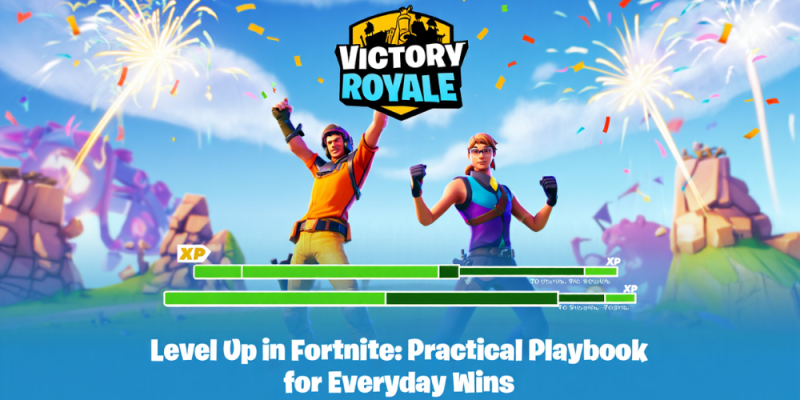Level Up in Fortnite: Practical Playbook for Everyday Wins
2025-09-22

Fortnite is a fast, colorful battle royale where smart choices beat luck. You jump from the Battle Bus, collect weapons and items, and try to be the last survivor or team. The map, loot, and meta change often, but core skills stay the same.
This guide is simple and hands-on. You will learn the basics that matter in every season: settings, landing, looting, combat, building, Zero Build tactics, rotations, and a small routine to improve each day. Use these tips today and see instant progress.
Understand the Modes and Win Condition
Fortnite Battle Royale has two main ways to play: Build and Zero Build. Both share one goal: survive to the end while the storm closes the map.
- Build: You can place walls, floors, ramps, and cones. Good building gives safety, height, and smart peek angles.
- Zero Build: No building. Position, cover, aim, and utility items are your protection.
Quick Settings That Make You Better
Small setting changes can bring big results. Do these first:
- Frame rate and graphics: Aim for stable, high FPS. Lower shadows and effects. On PC, try Performance Mode if needed.
- Brightness and color: Raise brightness a bit and test a color-blind filter if it helps you spot enemies faster.
- Audio: Use headphones. Turn on 3D Audio and try “Visualize Sound Effects” for on-screen cues.
- Mouse: Start around 800 DPI with low-medium in-game sensitivity so you can track smoothly and turn 180 without lifting too often.
- Keyboard keybinds: Put build/edit binds near movement keys. Place wall and ramp on easy keys or mouse buttons.
- Controller: Try Linear response. Keep look sensitivity medium, with higher build/edit multipliers. Adjust until aim feels steady, not twitchy.
Landing: Start Each Match With a Plan
Your drop decides your first two minutes. A clean start means better gear and safer rotations.
- Pick two home drops: Learn their chest spawns, floor loot, cars, and rotation paths. Consistency beats random hot drops.
- Glide smart: Jump when you are roughly 1000–1200 meters from your spot. Dive straight, then glide low to land first on a roof or a floor gun.
- Weapon first, chest second: A floor gun wins early fights. Don’t lose time to long chest animations if an enemy is near.
- Early fight rules: Use cover, keep your crosshair head-high, and commit only if you have better position or surprise.
Looting and Managing Your Inventory
A good loadout covers close, mid, and mobility/heal needs. Keep it simple and repeatable.
- Build standard: Shotgun + SMG or AR + Long-range (AR/DMR) + Heals + Mobility (Shockwaves, Grapple, car).
- Zero Build standard: AR/DMR + SMG or Burst + Heals + Utility (Shield Bubble, Port-a-Bunker, Shockwaves).
- Heals: Minis are king during fights. Big Pots are for after. Med-Mist is fast and flexible.
- Upgrades and rarity: Blue guns are fine. Don’t risk fights just to chase a purple. Upgrade only when safe.
- Inventory order: Keep the same slot order every game. Muscle memory saves seconds in clutch moments.
Combat Fundamentals: Aim, Movement, Timing
You will win more by cleaning small habits than by hunting perfect loot.
- Crosshair placement: Keep it at head or upper chest height while moving. You will hit first shots more often.
- Strafe and crouch: Move left-right with rhythm changes. Add short crouches to break enemy tracking.
- Peek with cover: Use rocks, trees, windows, and corners. Show less of your body than the enemy does.
- Shotgun rhythm: Breathe. Wait a tiny moment for a clean pellet spread, then swap to SMG/AR to finish.
- Burst control: With AR/DMR, fire in short bursts for accuracy at mid-long range.
- Utility damage: Grenades, explosives, and Shockwaves force enemies out of comfort spots. Push right after you force movement.
Building Essentials You Will Actually Use
In Build, focus on a tight toolkit you can rely on under pressure.
- Box up fast: Four walls, floor, and cone. Reset edits to block enemy shots. Heal safely.
- Right-hand peek: Edit a right window or corner so your camera sees them before they see you.
- Wall replace: Break an enemy wall, place your wall, then edit for a quick shot. Reset if the trade is bad.
- Ramps and 90s: Gain height quickly while staying covered by your own walls.
- Heal structure: Box, cone above, maybe double-floor the ground. Never heal in the open.
Editing tips: Practice slow, clean edits. Wall window, wall corner, floor reset, ramp flip. Consider “confirm on release” if it feels comfortable.
Zero Build: Win With Position and Tools
Without builds, the map itself is your shield.
- Cover chain: Move from cover to cover. Plan the next rock, tree, or wall before you leave the current one.
- Height and angles: Hills, rooftops, and ridges are strong. Take them early instead of fighting uphill later.
- Utility wins fights: Port-a-Bunker and Shield Bubble create instant cover to heal, reload, or revive.
- Crossing open areas: Use Shockwaves, grapples, or smokes/visual blockers if available. Never run a long open line without a plan.
Rotations and Storm Discipline
Rotations are how you move safely from zone to zone. Good rotations feel calm; bad ones feel rushed and messy.
- Plan early: Check the map before the circle moves. Choose paths along edges or through cover, not straight through the center.
- Timing: Leave 10–20 seconds before the crowd. Early movers avoid gatekeepers at zone lines.
- Vehicles: Useful for long moves, but noisy. Drive to a safe area, park behind cover, then continue on foot.
- Endgame choices: In Build, play low ground and “tarp” with floors and cones if you are not confident on height. In Zero Build, play the edge with clear cover options.
Game Sense: Read Audio, Vision, and Risk
Game sense is choosing when to fight, when to wait, and when to rotate.
- Audio cues: Footsteps, mantles, zip-lines, and reload sounds tell you range and timing. Push when you hear a long reload.
- Shield crack: If you break an enemy’s shields, close distance and finish before they heal.
- Third-party timing: Join fights only when someone is cracked or knocked. Don’t chase too far and lose the safe rotation.
- Risk rule: If a fight gives low reward and high risk (bad zone, low mats/heals), skip it.
Team Play: Clear Roles and Simple Comms
In Duos, Trios, and Squads, clear talk wins games.
- Short comms: Share enemy count, location, armor status, and plan. Example: “Three on bridge, cracked one, swing right.”
- Focus fire: Count down and shoot the same target. One knock flips the fight.
- Role basics: One IGL (calls rotates), one entry fragger, one support for utility and revives. Rotate roles if needed.
- Revive safety: Create cover first (builds or utility), then revive. Drop heals on the downed teammate.
Mental Game and Consistency
Consistency beats streaky play. Keep a calm process even when you lose.
- One change at a time: Adjust one setting or habit per day so you can feel the difference.
- Reset after losses: Take a 2-minute break. Stretch, sip water, then queue again.
- Play your plan: If your plan is edge rotation and third-party fights, don’t switch to reckless hot drops mid-session.
Daily Practice Plan (30–45 Minutes)
This short routine builds real skill without burnout:
- Aim warm-up (8–10 min): Practice close-range shotgun flicks and steady AR tracking. Focus on smooth motion.
- Edits and builds (8–10 min): Box up, right-hand peeks, wall replaces, 90s. Slow, controlled reps.
- Realistic fights or 1v1s (10–15 min): Simulate game scenarios. Work on timing and damage trades.
- One VOD check (3–5 min): Watch a recent death. Ask: Did I have cover? Was my crosshair ready? Did I rotate too late?
Common Mistakes You Can Skip
- Landing random every match: Without a home drop, you never learn routes or timings.
- Healing in open space: Always heal in a box, behind cover, or inside a utility item.
- Chasing upgrades in danger: A safe blue gun beats a risky purple.
- Overbuilding: Place builds with a job—protect, peek, move. Don’t waste mats for no reason.
- Late rotations: Moving at the last second gets you beamed by players already set up.
- Tunnel vision after a knock: Secure the finish safely, then reset. Don’t run into a teammate’s crossfire.
Adapting to Updates and New Seasons
New items and POIs arrive often, but your system stays steady.
- Test first: Try new guns in casual matches. Learn recoil, fire rate, and best ranges.
- Find mobility: Movement defines rotations and endgame choices. Prioritize it early.
- Update your drop: If your POI changes, explore it in a few casual games before ranked.
- Keep the core: Crosshair discipline, cover, timing, and early rotations always work.
Sample Match Flow
- Bus: Mark your home drop. Visualize first loot path.
- Land: Grab a floor gun, pop Minis, clear the POI or rotate away if third-parties arrive.
- Mid game: Upgrade only if safe, gather mobility, plan the next two zones.
- Late game: Position early on edge with cover. In Build, tarp if pressured; in Zero Build, secure height or solid hard cover.
- Endgame: Play for picks, avoid risky peeks, and keep heals ready for the final 1v1 or storm hold.
Conclusion
Winning more in Fortnite is a set of simple, repeatable habits. Use smart settings, land with a plan, choose a clean loadout, play around cover, and rotate before the crowd. In Build, rely on boxes, right-hand peeks, and calm edits. In Zero Build, rely on position, utilities, and timing.
- Stick to one or two drop spots and learn them deeply.
- Carry Minis and at least one mobility or utility item.
- Hold your crosshair at head height and peek from safety.
- Rotate early along covered paths; avoid open centers.
- Practice a little each day and review one mistake. Improve one thing at a time.
Follow this playbook and your fights will feel cleaner, your rotations calmer, and your win rate higher—no matter how the season changes.




